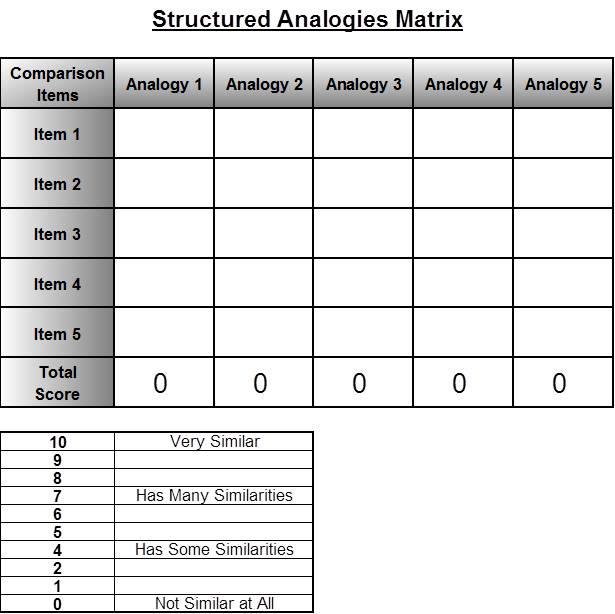
Structured Analogies Matrix
Compare your problem to multiple analogies.
Analogies are one of the most common ways that people solve problems. It just makes sense to repeat actions that were successful in similar situations in the past. Unfortunately, it’s easy to become preoccupied with the first analogy that comes to mind instead of picking the best ones. The Structured Analogies Matrix tool will help you develop a wide range of choices, so you can choose the best among many.
Step 1: Create a list of as many analogies as you can think of. Think of analogous situations from past experiences. You can also use the Analogies tool to generate analogies.
Step 2: Develop a list of items for comparing to your analogies. It may be helpful to refer to Factors, Forces, and Major Categories for these. In any case, make sure the items you choose are appropriate for comparing your analogies to your problem.
Step 3: Build a matrix with your comparison items down the left-hand column and your analogies across the top.
Step 4: Assign a similarity rating to each item/analogy pairing. Use a scale of 0 to 10, where 0 is not similar at all to your problem, 5 is somewhat similar, and 10 is very similar.
Step 5: Rank your analogies from most similar to least similar.
Step 6: Compare the most similar analogies to your problem. Examine: a) what is known, b) what is unclear, and c) what is merely presumed.
Step 7: Pay special attention to the differences between your problem and your analogies.
Diagram: Here's a the diagram our Structured Analogies Matrix.

Word version of Structured Analogies Matrix.docx (Click link to download Word version).
Excel version of Structured Analogies Matrix.xlsx (Click link to download Excel version).
PDF version of Structured Analogies Matrix.pdf (Click link to download PDF version).

Sources:
Structured Analogies for Forecasting, Kesten C. Green and J. Scott Armstrong, International Journal of Forecasting, Volume 23, Number 3, 2007, p. 365-376.
Thinking in Time, Ernest R. May and Richard E. Neustadt, New York: The Free Press, 1986.
Handbook of Analytic Tools and Techniques, Randolph H. Pherson, Reston, VA: Pherson Associates, 2008.
Structured Analytic Techniques for Intelligence Analysis, Richards Heuer, Jr. and Randolph H. Pherson, Washington DC: CQ Press, 2011.
